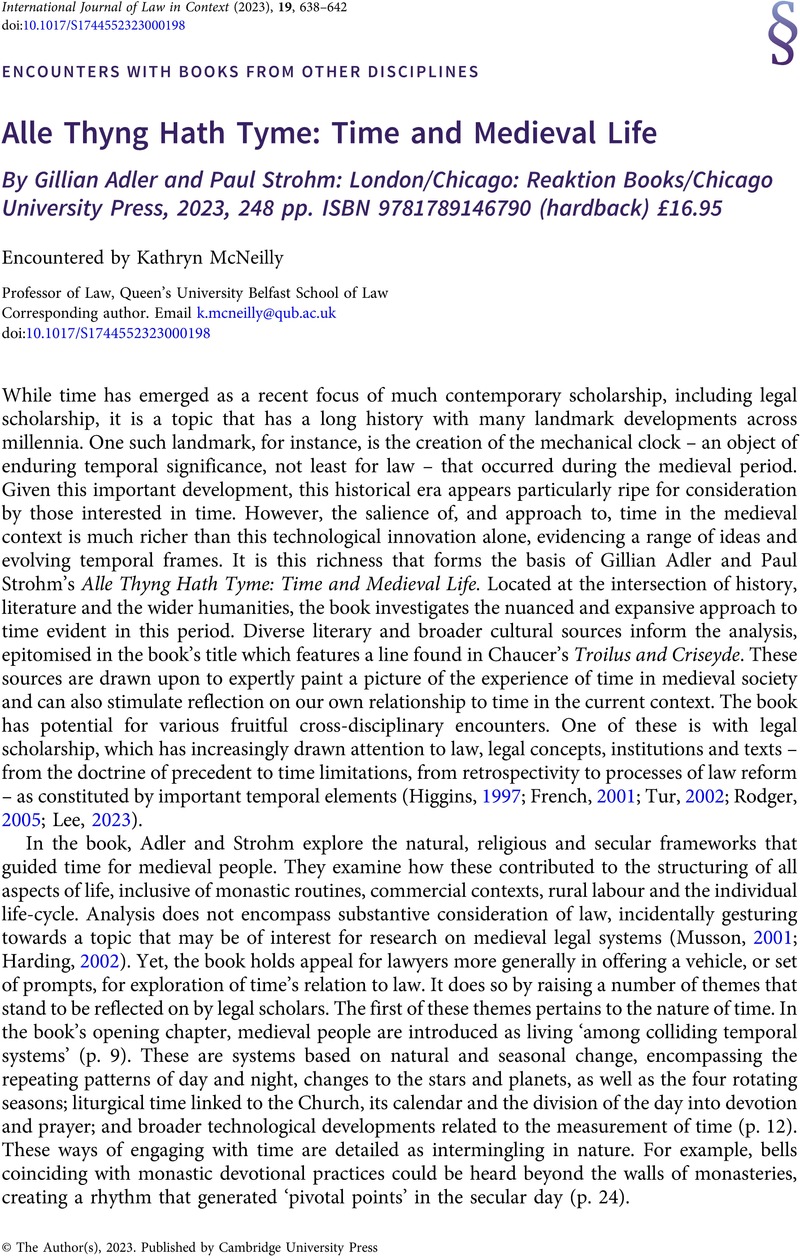No CrossRef data available.
Article contents
Alle Thyng Hath Tyme: Time and Medieval Life By Gillian Adler and Paul Strohm: London/Chicago: Reaktion Books/Chicago University Press, 2023, 248 pp. ISBN 9781789146790 (hardback) £16.95
Review products
Alle Thyng Hath Tyme: Time and Medieval Life By Gillian Adler and Paul Strohm: London/Chicago: Reaktion Books/Chicago University Press, 2023, 248 pp. ISBN 9781789146790 (hardback) £16.95
Published online by Cambridge University Press: 04 August 2023
Abstract
An abstract is not available for this content so a preview has been provided. Please use the Get access link above for information on how to access this content.

- Type
- Encounters with Books from Other Disciplines
- Information
- Copyright
- © The Author(s), 2023. Published by Cambridge University Press
References
d’Aspremont, J (2022) Time Travel in the Law of International Responsibility. In Besson, S (ed), Theories of International Responsibility Law. Cambridge: Cambridge University Press, pp. 252–278.CrossRefGoogle Scholar
Djeffal, C (2014) International Law and Time: A Reflection of the Temporal Attitudes of International Lawyers Through Three Paradigms. Netherlands Yearbook of International Law 45, 93–119.CrossRefGoogle Scholar
Gordon, G (2018) Railway Clocks. In Hohmann, J and Joyce, D (eds), International Law’s Objects. Oxford: Oxford University Press, pp. 387–398.CrossRefGoogle Scholar
Grabham, E (2016) Brewing Legal Times: Things, Form, and the Enactment of Law. Toronto: University of Toronto Press.CrossRefGoogle Scholar
Greenhouse, C (1989) Just in Time: Temporality and the Cultural Legitimation of Law. Yale Law Journal 98, 1631–1651.CrossRefGoogle Scholar
Harding, A (2002) Medieval Law and the Foundations of the State. Oxford: Oxford University Press.CrossRefGoogle Scholar
Higgins, R (1997) Time and the Law: International Perspectives on an Old Problem. International and Comparative Law Quarterly 46, 501–520.CrossRefGoogle Scholar
Lee, J (2023) ‘Not Time to Make a Change?’ Reviewing the Rhetoric of Law Reform. Current Legal Problems XX, 1–43.Google Scholar
McNeilly, K (2021a) The Temporal Ontology of the Human Rights Council’s Universal Periodic Review. Human Rights Law Review 21, 1–21.CrossRefGoogle Scholar
McNeilly, K (2021b) How Time Matters in the UN Human Rights Council’s Universal Periodic Review: Humans, Objects and Time Creation. Leiden Journal of International Law 34, 607–627.CrossRefGoogle Scholar
Musson, A (2001) Medieval Law in Context: The Growth of Legal Consciousness from Magna Carta to the Peasants’ Revolt. Manchester: Manchester University Press.Google Scholar
Rodger, A (2005) A Time for Everything under the Law: Some Reflections on Retrospectivity. Law Quarterly Review 121, 57–79.Google Scholar
van Oorschot, I (2019) Doing Times, Doing Truths: The Legal Case File as a Folded Object. In Beynon-Jones, S and Grabham, E (eds.) Law and Time. London: Routledge, pp. 229–246.Google Scholar




